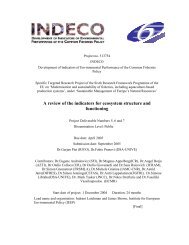WP5 Case study on genetic resources in food and agriculture
WP5 Case study on genetic resources in food and agriculture
WP5 Case study on genetic resources in food and agriculture
Create successful ePaper yourself
Turn your PDF publications into a flip-book with our unique Google optimized e-Paper software.
esources. Most commercially grown crops, vegetables <strong>and</strong> soft fruits are dom<strong>in</strong>ated byfew high-yield<strong>in</strong>g varieties. Especially for annual crops there is hardly any cultivati<strong>on</strong> ofold varieties. It is estimated that compared to the first half of the twentieth century, 75 percent of cultivated plants <strong>in</strong> <strong>agriculture</strong> <strong>and</strong> horticulture have disappeared (UBA, 2002 <strong>in</strong>:Wolff, 2004). Although Germany has a l<strong>on</strong>g history of scientific research <strong>in</strong>to plant<strong>genetic</strong> <strong>resources</strong>, there is no complete <strong>in</strong>ventory of cultivated plant species <strong>and</strong> varieties,let al<strong>on</strong>e written comprehensive <strong>in</strong>formati<strong>on</strong> about management <strong>and</strong> utilisati<strong>on</strong>techniques. In the case of vegetables, fruits <strong>and</strong> herbs private gardens surely still hold ahigher variety of plants. On-farm management happens e.g. <strong>in</strong> agricultural <strong>and</strong> historicalopen-air museums.Plant breed<strong>in</strong>g <strong>in</strong> Germany is ma<strong>in</strong>ly organised privately (except fruit <strong>and</strong> v<strong>in</strong>e). TheSaatgutverkehrsgesetz (SaatG, German Seed Trad<strong>in</strong>g Law) dem<strong>and</strong>s compulsory varietyapproval <strong>and</strong> registrati<strong>on</strong>, requir<strong>in</strong>g compliance with the DUS-criteria <strong>and</strong> proof of Valuefor Cultivati<strong>on</strong> <strong>and</strong> Use (VCU) (§30(1), 34 SaatG). VUC <strong>in</strong>cludes criteria such as qualityof cultivati<strong>on</strong>, resistance, yield <strong>and</strong> quality, yield still be<strong>in</strong>g the predom<strong>in</strong>ant <strong>in</strong>dicator(Wolff, 2004). New varieties must show a dist<strong>in</strong>ct improvement compared to exist<strong>in</strong>gvarieties, <strong>and</strong> around 90 per cent of applicati<strong>on</strong>s fail because of these VUC requirements(Ste<strong>in</strong>berger J. <strong>in</strong> Wolff, 2004). The test<strong>in</strong>g is carried out by the Bundessortenamt(Federal Agency for Varieties) <strong>and</strong> is paid for by the breeders’ organisati<strong>on</strong>. Traditi<strong>on</strong>alseed-supply systems are lost almost completely (Efken, 2004).Thus, there are new developments as well. There is a ris<strong>in</strong>g <strong>in</strong>terest <strong>and</strong> need for varietiesdeveloped accord<strong>in</strong>g to specific guidel<strong>in</strong>es of organic farm<strong>in</strong>g associati<strong>on</strong>s. As theBMELV aims to <strong>in</strong>crease the share of organically farmed l<strong>and</strong> <strong>in</strong> Germany, the potentialfor <strong>on</strong>-farm management activities will rise accord<strong>in</strong>gly (Efken, 2004). Interest <strong>in</strong> use ofplants as renewable <strong>resources</strong> for materials or energy opens opportunities for are<strong>in</strong>troducti<strong>on</strong> of old species (such as flax <strong>and</strong> hemp), but the full range of uses is still tobe developed.Ex situ c<strong>on</strong>servati<strong>on</strong> of plant <strong>genetic</strong> <strong>resources</strong> happens at six places <strong>in</strong> two publicresearch <strong>in</strong>stituti<strong>on</strong>s, numerous botanic gardens <strong>and</strong> <strong>in</strong> around 20 special collecti<strong>on</strong>s, butthere is by far not enough capacity for a complete c<strong>on</strong>servati<strong>on</strong> because of the high<strong>genetic</strong> diversity of wild plants. Research <strong>on</strong> the c<strong>on</strong>servati<strong>on</strong> of plant <strong>genetic</strong> <strong>resources</strong> isdom<strong>in</strong>ated by the requirements <strong>and</strong> techniques for improv<strong>in</strong>g ex situ c<strong>on</strong>servati<strong>on</strong>. Agreat deal of research is be<strong>in</strong>g d<strong>on</strong>e <strong>in</strong> the field of the characterisati<strong>on</strong> <strong>and</strong> evaluati<strong>on</strong>.Little scientific experience has been gathered <strong>in</strong> the area of <strong>in</strong> situ <strong>and</strong> <strong>on</strong>-farmc<strong>on</strong>servati<strong>on</strong>. Practical <strong>and</strong> scientific work <strong>in</strong> this area is ma<strong>in</strong>ly carried out by a numberof German n<strong>on</strong>governmental organisati<strong>on</strong>s. Research <strong>on</strong> the potential use of naturereserves for the c<strong>on</strong>servati<strong>on</strong> of <strong>genetic</strong> <strong>resources</strong> was ma<strong>in</strong>ly carried out <strong>in</strong> the formerGDR prior to reunificati<strong>on</strong>.25




